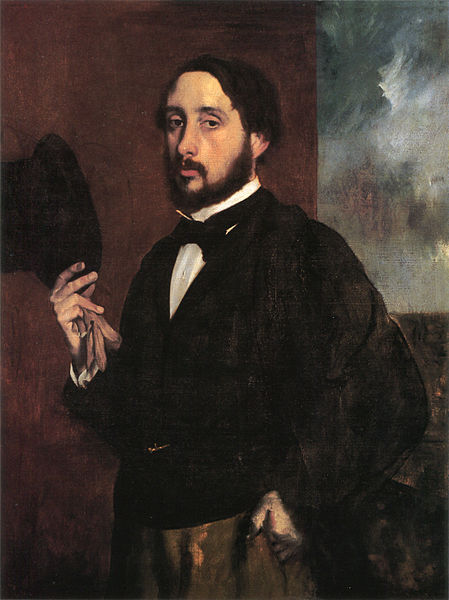
Born:
Died:
Period:
The Life of Edgar Degas
Edgar Degas was a French artist famous for his contributions to the Impressionist movement, though he preferred to be called a realist. Born Hilaire-Germain-Edgar De Gas in Paris, into a wealthy family, Degas initially pursued law to please his father but soon shifted his focus to art. He studied at the École des Beaux-Arts under Louis Lamothe, a pupil of the classical painter Jean-Auguste-Dominique Ingres, whose influence is evident in Degas’ early works.
Degas’ artistic journey is marked by his rigorous study of movement and his exploration of various subjects, including ballet dancers, horse races, and scenes of Parisian life. He is best known for his masterful depictions of ballet dancers, which constitute more than half of his work. These pieces, often featuring dancers backstage or in rehearsal, showcase his interest in capturing movement and the human form in unconventional poses and from unique perspectives.
Unlike many of his contemporaries in the Impressionist movement, Degas was less interested in painting en plein air and landscapes. Instead, he was drawn to the human figure and indoor scenes, which he rendered with meticulous detail and a keen sense of composition. His work is characterized by its experimental use of color and light, and a distinct blend of traditional techniques with new approaches to subject and form.
Throughout his career, Degas experimented with a variety of media, including oil, pastel, and sculpture, demonstrating his versatility and innovative spirit. His later works increasingly utilized pastels, which allowed him to capture the ephemeral qualities of light and movement with greater spontaneity.
Degas was an introverted and private individual, known for his sharp wit and somewhat pessimistic outlook on life. Despite his critical nature, he was deeply involved in the Impressionist movement, participating in several of their exhibitions. However, his conservative views on politics and society, as well as his aversion to the label of Impressionism, often set him apart from his peers.
In his later years, Degas struggled with failing eyesight, which eventually led him to focus more on sculpture. Despite his physical limitations, he continued to work until his death in 1917. Degas never married and remained somewhat isolated, dedicating his life to his art.
Today, Edgar Degas is celebrated as a master of modern art, whose innovative techniques and unique approach to subjects like the ballet have left a lasting impact on the world of art. His works continue to captivate audiences with their beauty, technical skill, and emotional depth.
Edgar Degas’s Notable Works
Edgar Degas was a prolific artist whose work spans various subjects and media, including painting, sculpture, and drawing. Here are ten of his most famous and celebrated works, each showcasing his mastery of capturing human figures in motion and his innovative approach to composition and color:
- “The Dance Class” (La Classe de Danse), c. 1874 – This painting captures a group of ballet dancers during a rehearsal, showcasing Degas’ fascination with ballet and his ability to depict the nuances of movement and posture.
- “L’Absinthe” (1876) – A striking portrayal of Parisian life, this painting features two figures, a woman and a man, sitting in a café, exuding a sense of loneliness and desolation amidst the bustling city life.
- “The Ballet Rehearsal” (1873) – Another example of Degas’ interest in ballet, this work presents dancers rehearsing on stage, offering a behind-the-scenes look at the ballet world with a unique, elevated perspective.
- “Two Dancers on a Stage” (c. 1874) – This painting is celebrated for its vibrant colors and the dynamic positioning of the dancers, highlighting Degas’ skill in rendering movement and light.
- “The Millinery Shop” (1879-1886) – Degas explores the theme of Parisian workers, focusing here on a hat shop and its milliners, showcasing his attention to detail and the texture of fabrics.
- “At the Races” (c. 1869-1887) – A series of works rather than a single painting, these pieces reflect Degas’ interest in horse racing, capturing the energy and excitement of the races with dynamic compositions.
- “The Tub” (1886) – Part of Degas’ exploration of the theme of women bathing, this work is notable for its intimate perspective and the innovative use of pastel to render the human form and water.
- “Miss La La at the Cirque Fernando” (1879) – This painting depicts a famous circus performer, Miss La La, hanging from a trapeze by her teeth, showcasing Degas’ interest in unusual subjects and perspectives.
- “Portrait of Édouard Manet and Mme. Manet” (c. 1868-1869) – Although not as well-known as his other works, this portrait is significant for its depiction of Degas’ contemporary, Édouard Manet, highlighting the friendship and mutual respect between the two artists.
- “Little Dancer of Fourteen Years” (La Petite Danseuse de Quatorze Ans), c. 1881 – This bronze sculpture is perhaps Degas’ most famous work outside of painting and pastel, representing a young ballet dancer in a realistic, yet tender and nuanced manner. The original was modeled in wax, dressed in a real ballet costume, and is notable for its lifelike quality and attention to detail.
These works collectively exemplify Degas’ contributions to the Impressionist movement, his innovative use of composition and light, and his enduring fascination with the human figure in motion.